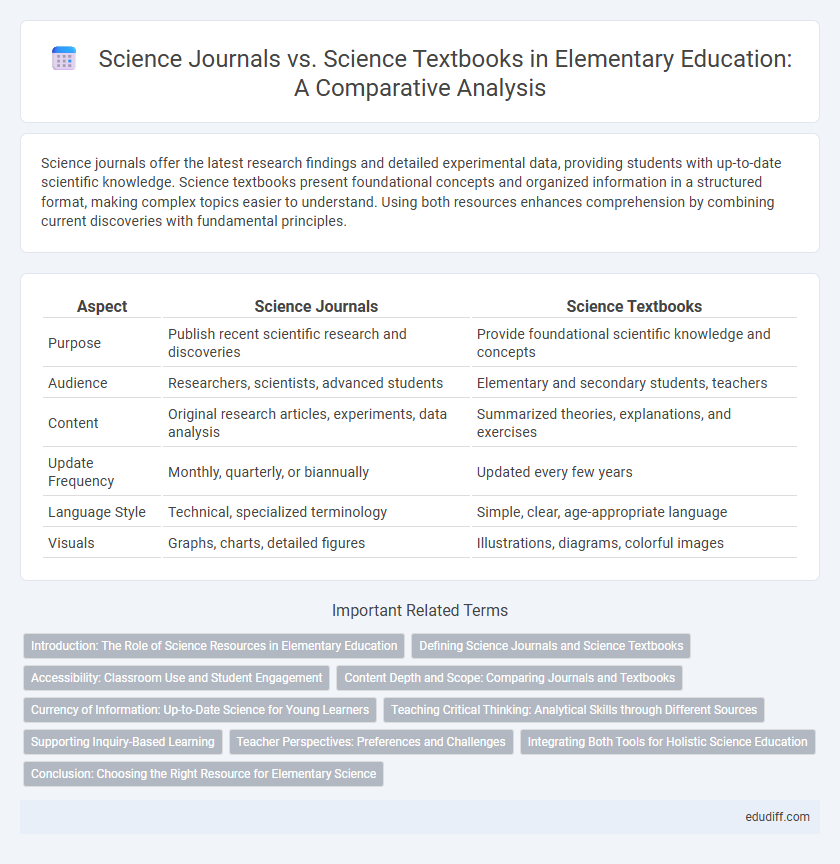Science journals offer the latest research findings and detailed experimental data, providing students with up-to-date scientific knowledge. Science textbooks present foundational concepts and organized information in a structured format, making complex topics easier to understand. Using both resources enhances comprehension by combining current discoveries with fundamental principles.
Table of Comparison
| Aspect | Science Journals | Science Textbooks |
|---|---|---|
| Purpose | Publish recent scientific research and discoveries | Provide foundational scientific knowledge and concepts |
| Audience | Researchers, scientists, advanced students | Elementary and secondary students, teachers |
| Content | Original research articles, experiments, data analysis | Summarized theories, explanations, and exercises |
| Update Frequency | Monthly, quarterly, or biannually | Updated every few years |
| Language Style | Technical, specialized terminology | Simple, clear, age-appropriate language |
| Visuals | Graphs, charts, detailed figures | Illustrations, diagrams, colorful images |
Introduction: The Role of Science Resources in Elementary Education
Science journals provide up-to-date discoveries and real-world applications that enhance curiosity and critical thinking in elementary students. Science textbooks offer structured, curriculum-aligned content that builds foundational knowledge and supports standardized learning goals. Both resources play a crucial role in fostering a comprehensive understanding of scientific concepts at the elementary level.
Defining Science Journals and Science Textbooks
Science journals are periodicals that publish new and original research findings, written by scientists for scientists, often including peer-reviewed articles and detailed experiments. Science textbooks are educational resources designed for students, summarizing established scientific knowledge and principles in a structured and accessible format. While journals focus on cutting-edge discoveries, textbooks emphasize foundational concepts and curriculum-aligned content.
Accessibility: Classroom Use and Student Engagement
Science journals provide up-to-date research and real-world discoveries that enhance student engagement through authentic content. Science textbooks offer structured and comprehensive explanations, making complex concepts more accessible for classroom use. Combining both resources supports diverse learning styles and fosters deeper understanding among elementary students.
Content Depth and Scope: Comparing Journals and Textbooks
Science journals offer in-depth, cutting-edge research articles that present new discoveries and detailed data, making them ideal for exploring specific scientific topics thoroughly. Science textbooks provide a broad overview of established knowledge across multiple disciplines, designed to teach foundational concepts in a structured and accessible way. While journals focus on current advancements, textbooks emphasize comprehensive learning and conceptual understanding suitable for elementary science education.
Currency of Information: Up-to-Date Science for Young Learners
Science journals provide the most current discoveries and research findings, ensuring young learners access the latest scientific knowledge. Science textbooks, while reliable, often have a delayed update cycle reflecting information that may be several years old. Prioritizing journals supports teaching with cutting-edge science, helping students stay informed about recent advances and trends.
Teaching Critical Thinking: Analytical Skills through Different Sources
Science journals present current research and real experiments, helping elementary students develop analytical skills by engaging with authentic scientific data and methods. Science textbooks provide structured knowledge and guided explanations, which build foundational understanding necessary for critical thinking. Combining both sources encourages students to compare information, question findings, and strengthen their problem-solving abilities in science.
Supporting Inquiry-Based Learning
Science journals provide up-to-date research findings that encourage students to ask questions and explore experiments independently, fostering critical thinking and curiosity. Science textbooks offer foundational knowledge and structured content that helps students understand key concepts needed for inquiry-based activities. Combining journals and textbooks supports inquiry-based learning by blending current scientific discoveries with essential background information.
Teacher Perspectives: Preferences and Challenges
Teachers often prefer science journals for their up-to-date research findings and real-world applications that enhance student engagement. Science textbooks provide structured content aligned with curriculum standards, facilitating lesson planning and assessment. Challenges include balancing the accessibility of textbooks with the complexity of journal articles, making it crucial to select resources that support diverse learning needs.
Integrating Both Tools for Holistic Science Education
Science journals provide current research findings and real-world applications that enhance curiosity and critical thinking in elementary students. Science textbooks offer foundational knowledge and structured content that helps build a strong understanding of basic scientific concepts. Integrating both tools supports a comprehensive science education by combining updated information with essential learning frameworks.
Conclusion: Choosing the Right Resource for Elementary Science
Science journals offer up-to-date discoveries and detailed experiments, making them ideal for promoting curiosity and critical thinking in elementary students. Science textbooks provide structured lessons and foundational knowledge aligned with curriculum standards, ensuring consistent learning progress. Selecting the right resource depends on balancing current scientific developments with age-appropriate, organized content to enhance elementary science education.
Science Journals vs Science Textbooks Infographic

 edudiff.com
edudiff.com